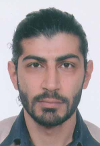Europäische Kulturtage Karlsruhe 2016
|
|
Ghiath Al Jebawi Referent |
Curriculum Vitae
Ghiath Al Jebawi is a Syrian architect and urbanist; master student at the Politecnico di Milano, Italy. Until 2011, he studied architecture and urban planning and environment at Damascus University. In 2011, he worked at Damascus University as an assistant lecturer at the Department of urban planning and environment. After that, Al Jebawi moved to Beirut and later Venice where he worked in language, art and architecture before he started his master degree studies in architecture at the Politecnico di Milano in Italy. Among other things, Al Jebawi worked for the project "Alkelania District Archaeological Site”, that gained an honourable mention at the "Young Arab Architect Award (Y.A.A.)" in 2012. Al Jebawi also published on topics such as urban planning, the war in Syria and the situation of Syrian refugees in German cities. In January 2016, he commented the New Year’s Eve attacks in Cologne with the article “After the Cologne attacks, refugees must be housed within the wider community“ in the British newspaper The Guardian.
Abstract
Different types of refugees and city question in Europe.
Introduction
1- Flux of refugees map
2- Syria’s very short story and the history of refugees
3- Smuggling by sea and associated accidents
4- Images of the drowned child and media open the land root and then terrorist attacks and the New Year’s Eve harassments in Cologne close it.
A. Cities of Mobile Refugees / Mobile Cities of Refugees
1- The camps that are being born at each Balkan border when it is closed (Idomini).
2- Similarities to the camp in Calais (the Jungle).
3- History, urban and social structure, stories, and destiny of the jungle.
4- Grande-Synthe to replace Calais as a camp to meet the UNHCR standards
5- Temporary refugee camps in Cologne
B. Resettlement and integration in cities (Case of Cologne)
1- “Resettlement Dynamics and its Impact on the Urban Structures across the City” published in Wie unsere Zukunft entsteht
2- Leverkusener Modell and Welcome Refugees initiative.
3- The willingness of the refugee communities to integrate (in percent) and written comments (feedbacks from my questionnaire)
C. Creative solutions?
very brief introduction of solutions and questions

